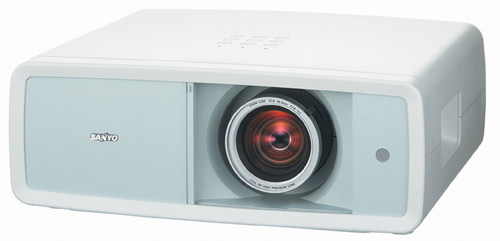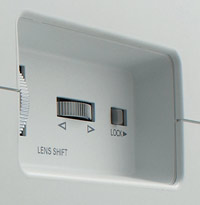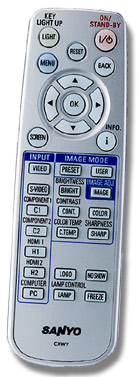SANYO PLV-Z2000 High Definition LCD Home Theater Projector Review
By Joe Lozito
Two thousand and fun!
I now pronounce me man and projector. I know, I know, I've said it before - SANYO projectors are great. Loyal
Big Picture Big Sound readers will recall fondly my rave review of SANYO's
PLV-Z5 LCD Home Theater Projector. It received our coveted four-star rating. Of course, the Z5's native resolution is 720p, so deep-down there was a voice saying, "Wait, just wait. There will be a SANYO 1080p projector soon."
Well, as the saying goes, good things come to those who wait. The patient among us have been rewarded with the
SANYO PLV-Z2000, SANYO's 1080p LCD Home Theater projector. Boasting full 1080p resolution, a new Epson LCD chipset for deeper blacks and a super-quiet fan, the PLV-Z2000 is a home theater enthusiast's dream.
But I'm getting ahead of myself. Let's start from the beginning.
Note: Limited time offer: Sanyo PLV-Z2000 available from authorized dealer for $1549.95 after two $300 mail-in rebates (rebates expire 5/31).
Find Out More
Let's get white to it
Those of you who have been following the pre-release hype for the Z2000 already know that its body leaves a little to be desired. Sure enough, while at first glance the Z2000 appears to be a bit smaller than its competitors (most notably Panasonic's
PT-AE1000U), the SANYO's antiseptic, eye-plaguing white color makes it appear twice as large. Since the colors it displays more than make up for the shade of the unit, I hope, dear reader, you can forgive SANYO for this misstep. After all, a ceiling mount is probably the most common way to install this, and most ceilings are white. If, however, the powers-that-be at SANYO would care to release a version in, oh I dunno, say, black. I'd be the first in line.

SANYO's 1080p PLV-Z2000 Front Projector.
But let's shove the Z2000 in a corner (Nobody puts the Z2000 in a corner!) and move on.
It's Pixel-icious!
In terms of what's new in the PLV-Z2000 over previous models, the biggest thing is the resolution - a full 1920x1080 pixels, also known as "Full HD." This is more than twice the detail of the PLV-Z5's 1280x720 resolution. And while those extra pixels may not make a big difference on smaller screens, they do come into play in the front projection space, where screens may be 100 inches, 120 inches or more, and first row seating may be a screen width away or less. More pixels means a clearer, sharper image from anywhere in the room.
The SANYO is one of the first projectors on the market to use Epson's new D7 Superfine 3LCD chip set. The D7 is made of an inorganic LCD substrate which is said to be more durable than previous 3LCD chips (longer lifespan). The D7 panels are also capable of much better contrast and black level than earlier LCD microdisplay devices, something that has always been a bit of an achilles heel for LCD projectors in the past. Because the light engine has three separate panels - one each for red, green and blue - it does not need a color wheel, and it supports a much wider degree of optical lens shift than single chip projectors.

The SANYO's lens shift controls are located on the side. A lens lock can be engaged when you achieve your target projection area.
You've heard (or read) me say it before and I'll say it again: nobody lens shifts like SANYO. The PLV-Z2000 continues SANYO's long-standing tradition of lens shifting like nobody's business. With a horizontal lens shift range of +/- 50% (2 screen widths) and a vertical lens shift range of +/- 100% (3 screen heights), the Z2000 can be positioned almost anywhere your heart desires. Lens shift is far superior to electronic keystone correction, as it loses no resolution and suffers no geometric distortion in the process. For the spatially-challenged (New York Audio-Video-philes, I'm looking in your direction), this is a must.
Did I mention the fan noise? I didn't? Oh. That's probably because I couldn't hear it. According to the documentation, the large aperture Sirocco cooling fan never rises above 19dB in economy mode. If they say so. All I know is, I have a pretty sensitive ear, and this is the quietest projector fan I've heard (or
not heard). In an open placement just a few feet from the top of viewer's heads, this is important to me.
Those who are interested in using the PLV-Z2000 with a Cinemascope (2.35:1) screen will be disappointed to find that the projector does not have a "vertical stretch" mode that would allow it to work with an anamorphic lens. This type of aspect ratio setting would allow the projector to take full advantage of all 1920x1080 pixels when projecting an ultra-widescreen film onto a Cinemascope screen. If you intend to use the projector in this fashion, you will need an outboard processor to perform the "anamorphic squeeze." Not a factor for those who are content with standard widescreen (16:9) projection, but 2.35:1 "fixed height" projection installations are becoming more common so it's worth noting.
Ready, Preset, Go
As is the case with any display, many of the factory presets on the Z2000 are too bright, too "contrasty" or inaccurate in color reproduction. Only the "Natural" mode plus a couple of the "Cinema" modes offered colors that were remotely accurate, with "Pure Cinema" mode coming in remarkably close to an accurate white color temperature, without any additional calibration. If you want to get this party started without professional calibration or tweaking, you could do much worse than "Pure Cinema" mode. Even with the presets it was clear that the Z2000 has a deeper black palette than its predecessors. Rated at 1200 lumens with a 15,000:1 dynamic contrast ratio (with dynamic iris enabled), the Z2000 also projects better in a bright environment than the previous Z-models, but for the best picture quality subdued room lighting is still a necessity.
In order to get a truly vivid picture out of the Z2000, it was time to break out the calibration tools.
As usual, I started with
Datacolor's SpyderTV Colorimeter. Calibrating a projector is always a challenge, but I enjoy the Spyder USB-PC interface. However, in this case the Spyder let me down. After my first round of calibration, the Spyder ended up at a setting that was too dark for my tastes - even to the naked eye in a darkened room. So I reverted to setting the picture controls manually using the "Avia Guide to Home Theater" DVD. Avia is a bit more of a manual process but its results can be striking. In this case, with the lamp set at economy mode (half-lamp indicator in the menu), and the SANYO's picture quality "enhancements" set to "off," (in the "advanced" picture menu) Avia produced the more accurate picture on the Z2000.
Now keep in mind, there are all sorts of RGB settings on the Z2000 that I didn't tinker with - the Z2000 has more Gamma than Bruce Banner. Video-tweaking hobbyists and calibration specialists will probably have a field day with the various advanced picture control settings. But my plan was to determine how good a picture the Z2000 could present with minimal configuration. Sure enough, with Avia, I got good clean results.

The PLV-Z2000 sports two HDMI and two High Def capable component video inputs, plus VGA, S-video and composite video inputs.
A source is a source, of course... not
Now it was time to pump some sources through the Z2000. When I switched over to my HD cable tuner, "
Borat" was the first thing to come on. As much as I wanted to watch everyone's favorite Kazakh, I needed something more... shall we say... challenging.
I spent the next hour or so switching back and forth between
"Happy Feet" and
"Fight Club" broadcast in 1080i. It's quite possible that I couldn't have chosen two more polar (pun intended) opposite movies. But what a great first test for the Z2000. "Happy Feet's" bright, vibrant whites and chilly blues were nearly blinding on the newly-calibrated Z2000, without being crushed. Meanwhile, the deep, grungy blacks of "Fight Club" were palpable with excellent shadow detail.
It was time to move on to some serious HD - namely Toshiba's HD-A35 1080p HD-DVD player (review coming soon). And what better inaugural HD content than that ode to cut pecs and ripped abs, "
300?"
At this point, something happened. Do you remember the first time, after years of watching VHS tapes, you first saw a DVD? Remember that feeling of awe? This was something like that. The full 1080p HD signal through the Z2000 was astounding. Say what you want about director Zack Snyder's gory, homoerotic melodrama, but it's visually stunning. From the opening fields of "Gladiator" wheat, through the underwater oracle, to the limb-slicing battles, "300" was a sight to behold. The culmination of years of waiting for a 1080p signal and an affordable 1080p projector. It's a whole new world. In fact, the Z2000's picture was so good, it actually made elements of "300" look less convincing. Suddenly, the actors didn't seem one with the CG-scenery and those giant elephants looked a bit, well, fake. I guess projectors like this are going to force Hollywood to step up their game.
The rest was pretty much cake. The original "Superman," "Serenity," "The Bourne Identity". I was hard-pressed to find an HD-DVD that didn't look superb on the Z2000. Clint Eastwood's "Unforgiven," in particular, gave me a start. I could nearly feel the prairie winds. Really, folks, this ain't hyperbole.
In terms of testing, we wanted to see how the PLV-Z2000 handled 1080i sources (e.g., broadcast HDTV), converting them to the projector's native 1080p resolution. It is possible to retrieve the original 1080p/24fps signal embedded in most 1080i sources, if the projector can correctly detect the 3:2 cadence in the source material and properly piece together (de-interlace) the fields into their original frames. To test this, we used the Silicon Optix HQV test disc (HD version) on HD-DVD and Blu-ray. When fed a video test pattern with single pixel high rows of alternating black and white (which appear in each alternate field in 1080i), the projector was able to resolve the individual lines in the signal, presenting a rock-solid 1920x1080 pixel test pattern. Also, in the de-interlacing testing ("jaggies" test patterns), the projector did a good job presenting moving diagonal lines without visible stair-stepping. On the film-based resolution test, the full details of a 1920x1080-based signal were also reproduced, but there was some minor strobing in the test pattern which suggests the projector's 3:2 cadence detection is not perfect (also borne out by the SD testing below).
But what about SD?
I may be getting a little caught up in the high-definition. Lest we forget, there's still quite a bit of standard-definition content out there. So, how does that fare on the Z2000? I'm happy to report that the SD content I viewed over cable and via my (non-upconverting) Onkyo DVD player looked fine. The cable content in particular looked smoother - far less pixely or obviously digital - than comparable projectors (even my own Z2).
Unfortunately, my eyes couldn't be the only test. It was time to call Silicon Optix into the mix...

The SANYO's remote control features direct input buttons and a handy backlight.
Using the standard definition version of Silicon Optix HQV test DVD, passed to the projector in 480i mode over HDMI, we subjected the projector to the usual battery of torture tests. In the standard definition "jaggies" tests, the projector did a great job reproducing a spinning line as well as three bouncing diagonal line segments. The SANYO's diagonal filter does an excellent job preventing stair-stepping distortion on these demanding test patterns. In film-based material, the jaggies were also not overtly bothersome on the waving flag test, and brick details in the background were sharp and clear. Other tests of detail produced clear and clean results.
But in the film detail test - a "Super Speedway" excerpt with a race car speeding along a track and a grandstand in the background - the Z2000 was not able to lock to the 3:2 cadence of this film-based source material. This produced the tell-tale curved line (moiré pattern) throughout the grandstand. Some processors lock to this cadence immediately, some take a second or two to detect it, but the SANYO that we had did not detect it at all which means it can have trouble producing rock solid detailed images from standard DVDs, connected to the set at 480i resolution. My advice - buy a good upconverting DVD player (or better yet a Blu-ray Disc or HD-DVD player with good upconversion of standard sources). This way the SANYO will do what it does best - reproduce 1080i or 1080p sources in pixel-perfect detail.
Remote Patrol
I need to mention it each time. Since my
Harmony 890 Universal Remote is already calibrated for the SANYO Z2, it works on the Z2000 (literally) right out of the box. Thank you, SANYO, for keeping your codes consistent. This will make the upgrade from a previous generation SANYO projector easier for those with brand loyalty.
If you don't have the Harmony or some other universal remote, however, the SANYO's included remote will definitely do the trick. With a bright orange backlight and large buttons, the Z2000's remote is a snap. It even has one-touch buttons for each different input (Component, HDMI, etc) and Image setting (Presets and User-defined).
Final Thoughts
Let's face it; I love the SANYO PLV-Z series projectors and the Z2000 has done nothing to change that opinion. I still have a PLV-Z2, and I've coveted the Z5 since our original review. But the Z2000 is really the one I've been waiting for. When fed high quality 1080p sources, the projector really shines with blinding whites and blacks that approach the depth of rival projectors costing 3 to 4 times as much. I never knew how good LCD's contrast could be until seeing/testing the Z2000.
Yes, full HD 1080p sources are few and far between, but there'll be more eventually. The projector is not the absolute best we have seen at de-interlacing and upconverting standard definition sources to its native panel resolution, but in actual viewing of standard def material, we were not overly bothered by any lack of detail or interlacing artifacts. In fact, the Z2000's treatment of standard definition material was eminently watchable, and better than what we have seen on many other displays. With an MSRP of $2,995.00, and a current street price of $2200 (after rebate), the answer is easy. The Z2000 rules.
Where to buy the SANYO PLV-Z2000:
Specifications from the Manufacturer:
- Brightness (Lumens): 1200 ANSI
- Contrast: 15000:1 (Dynamic)
- MSRP: $2995
- Weight: 16.1 lbs.
- Size (inches) (HxWxD): 5.7 x 15.7 x 13.6
- Zoom: Manual, 2.00:1
- Throw Dist (feet): 3.9 - 60.4
- Image Size (inches): 40.0 - 300.0
- Lens Shift: Horizontal (+/- 50%) and Vertical (+/- 100%)
- Warranty: 3 Years
- Suggested Retail Price: $2995.00
Compatibility:
- HDTV: 720p, 1080i, 1080p/60, 1080p/24
- EDTV/480p: Yes
- SDTV/480i: Yes
- Component Video: Yes (two inputs)
- Composite Video: Yes (one input)
- S-Video: Yes (one input)
- Digital Input: HDMI (HDCP) (two inputs)
- Personal Computers: Yes (one VGA D-sub-15 input)
Manufacturer's Contact Information:
SANYO Fisher Company
21605 Plummer Street
Chatsworth, CA 91311
website:
www.SANYOProjectors.com



